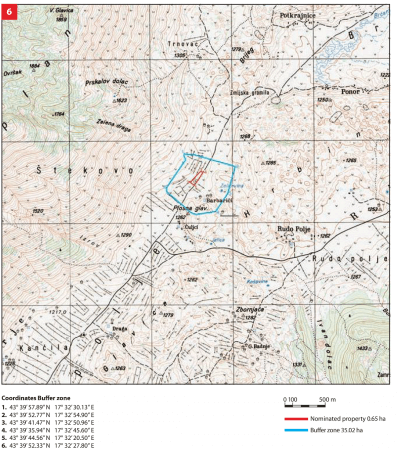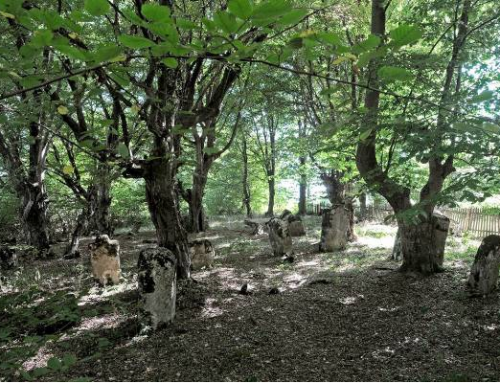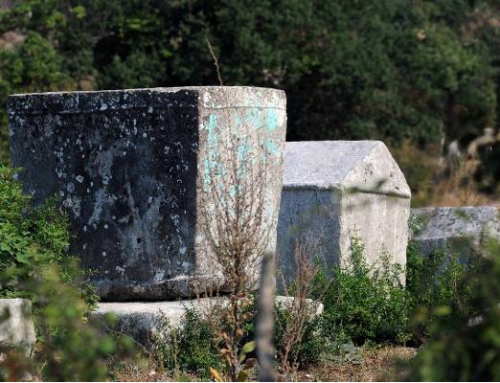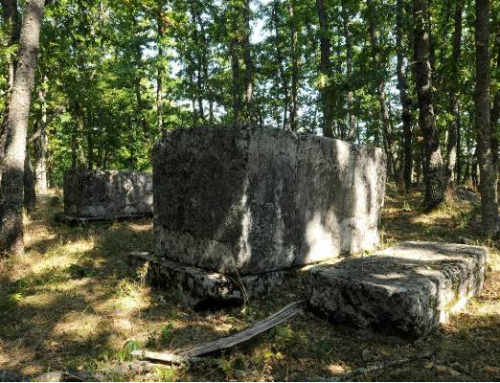About

Blidinje is a karst plateau extending north-east/south-west between the mountains of Čvrsnica, Muharica and Vran. Dugo polje, where the necropolis with tombstones is located, lies at the foot of Mount Vran between Lake Blidinje and Hrbin. It covers an area of 90 x 36 meters south of a macadam road. A few tombstones are oriented in the southeast-northwest direction. Several irregular fragments of slabs and chests sunk into the ground have been observed between the tombstones. All tombstones are made of limestone from a nearby quarry slopes of the Mount Vran or from Zreonice, where there was another quarry.
The necropolis has 150 tombstones; 72 slabs, 59 chests, 14 tall chests, 4 gabled roof tombstones with base and 1 gabled roof tombstone without base. Decorations are found on 32 tombstones: 5 slabs, 22 chests and 5 gabled roof tombstones – with the most common motif of rosettes appearing 34 times. There are 19 crosses, 4 of them stylized and 1 double cross. One tombstone bears an interesting combination, constituting one of the distinctive features of the necropolis – two arms of the cross ending as an anchor and two as trefoil lilies. There are 16 crescent moons, most frequently combined with a rosette. Edgings frame the panels in the form of twisted lines with spirals or trefoils in the empty spaces as well as incised zigzag lines. Some of the lines are S-shaped and some form detached spirals. One chest-shaped tombstone is interesting with an incised line as the edging on top and alongside densely arranged spiral lines on both sides. Circular wreaths, mainly twisted, appear eight times on four tombstones. Cable-cord ropes frame the lower edge of the roof panels of three gabled roof tombstones, creating the impression of the eaves of a house or the lid of a chest. A shield and sword appear in three places, and a sword alone in one. Two shields have heraldic symbols – rosettes or diagonal bands with a vegetal ornament in the form of a lily. The motif on one chest-shaped tombstone, resembling a tool of some kind, has yet to be identified.
Figural scenes include five hunting scenes, two jousting scenes, two wheel-dances (one only with women and one mixed) and one scene of three figures coming out of a tower. The warriors are on foot, armed with maces and swords. Animals alone – a deer with head raised and a horse – feature on two tombstones, while one arm features once. The most interesting figural scene is the one with a mythological animal, probably a winged horse with a serpent. Three figures with hands on their chests and five male figures with arms raised high are primarily symbolic in meaning.
No inscriptions have been recorded.
The site Dugo Polje has been inhabited since prehistoric times. At the site Barzonja, the remains of open prehistoric settlements were discovered. At the site Podjelinak, there is a prehistoric fort, a small settlement (50 x 25 meters), where pieces of earthenware and grindstones were found, probably dating from the Bronze and Iron Ages. At the site Sesaruša, the remnants of prehistoric ruins (85 x 85 meters) and a Roman fortification abounded in archaeological material pointing to the Bronze, Iron and Roman periods.
Three cairns: the Snake cairn next to the main road, another cairn in Risovac and a third one near the village of Orašac, most probably represented road signs, judging by their position and appearance, of a road passing through here in the Roman period.
Historical information on the region from the medieval period is scarce. From 1325, Blidinje had been part of the medieval Bosnian state ruled by the Kotromanić dynasty. In 1357, it was given, together with western Hum, to the Hungarian King Ludovik I as a dowry for his wife Elizabeth, daughter of Duke Stjepan II Kotromanić. After the death of King Ludovik, the area was regained by the medieval Bosnian state, under which it remained until 1463.
The medieval county of Drežnica covered the valley of Drežanka, Čvrsnica and Blidinje and surrounding fields. During the reign of Duke and King Tvrtko I Kotromanić, Duke Mastan Bubanjić lived in his palace in Drežnica. He had his estate in Blidinje in the 14th century – Masna luka, where he and his sons were engaged in cattle breeding. That was inscribed in Cyrillic on a solid rock in Donja Drženica in the 14th century.
The necropolises with tombstones, situated along the main road connecting Blidinje with Duvanjsko polje and Doljanska kotlina, prove that the area was populated in the medieval period. Blidinje includes other necropolises: Risovac, Ponor, Jezero, Donje Bare and Barzonja.
In later periods, especially during industrialization, the population migrated to other, mainly urban, areas, leaving those regions uninhabited.
The necropolis is situated on a parcel lying in a natural environment of Dugo polje on Mount Čvrsnica. The national monument is situated on a site encompassing parts of the parcels along the access road in a length of 100 meters, i.e. cadastral parcels 1928, 1929 and 1486/1 of the cadastral municipality of Risovac, Municipality of Jablanica, Federation of Bosnia and Herzegovina, Bosnia and Herzegovina; state ownership.
Location
The necropolis is situated on a plot located in the natural setting of Dugo polje on Čvrsnica Mountain. The parcel with tombstones covers an area of 90 x 36 meters and is defined by a gravel road track on the east, west and south sides.
State of the location
The site is in satisfactory condition. Upon completion of works on permanent systematic conservation of the tombstones, an inspection established that the tombstones on Dugo polje necropolis at Blidinje were in good condition. The state of conservation of the tombstones was also controlled under extreme weather conditions (very strong wind, rain and snow), in order to check the efficiency of hydrophobic protection.
The area is almost unpopulated and there are no buildings nearby yet that may impair the appearance of the area or block the view. Some tombstones were damaged by long-term weather impacts. At the north-eastern side of most of the tombstones, plant organisms are present, mostly lichen, which destroys the stone structure and threatens to permanently damage the decorations. In 2011 the entire site underwent geodetic survey supported with photographs of individual tombstones thus enabling for implementation of a monitoring process.
FAQ
Facilities for visitors and infrastructure
The Municipality of Jablanica has tried to secure funding through the projects of environmental protection for the Dugo polje site. The Strategy for cultural development of the Municipality of Jablanica currently in the process of adoption by the Municipal Council, will make this and other national monuments an asset in developing culture and economy. There is an immediate risk of inappropriate use of the necropolis area and surroundings (opening of inappropriate communications along the north side of the necropolis, as well as through the necropolis). In the immediate vicinity of the necropolis (300–400 meters) there is a family house owned by Kata Perko with 5 members of the household, as well as the „Šišović“ cattle farm. The existing tourist facilities cannot even remotely meet the visitors’ requirements, due to poor access road (macadam), lack of information office with printed materials and souvenirs and lack of tourist guides. A year ago, one Jablanica based NGO conducted a training for future tourist guides which, among other things, included this cultural property for which there is no visitor management plan. Certificates were issued to 15 trainees. The Dugo polje national monument, along with other national monuments in the area of Jablanica Municipality, is promoted mainly at local level through brochures, local websites and local radio and TV stations. The Municipality of Jablanica is the leading actor in these activities. Due to the stereotype about „cultural heritage existing only in Mostar, and somewhat in Stolac and Konjic“, the cultural property in the municipal area of Jablanica is neglected and thus insufficiently presented to the general public. Such attitude is visible on all info boards of the Herzegovina-Neretva Canton Tourist Board posted along the M-17 road as well as in their tourist brochures. Nobody works on promoting the cultural heritage national monument of Dugo polje Risovac-Blidinje. There is only one active cultural institution in the Municipality of Jablanica – the Public Institution „Museum of the Battle for the Wounded on the Neretva River“ with five employees. At last year training for tourist guides from the area of Jablanica Municipality, local and people from technical assistance regional centres were hired, and a total of 15 high-school and faculty students were trained to be professional tourist guides. The site of Dugo polje in Risovac is located in the immediate vicinity of Risovac winter sports and recreation centre, and some motels and restaurants are very close to the necropolis. The construction of necessary tourist and catering infrastructure as well as physical protection of the necropolis parterre and environment would establish the prerequisites for putting the cultural property to use, provided, of course, that all other requirements addressed in the questionnaire have been met. According to the assessment made by the management of the PI „Museum of the Battle for the Wounded on the Neretva River“ in Jablanica, this memorial complex of the Battle on the Neretva River is visited by approximately 20,000 visitors annually. It is estimated that the construction of the main exhibit (broken bridge) could get this number quadrupled. Accurate data on the number of visitors of religious and cultural destinations such as „grob Dive Grabovčeve“ (grave of Grabovac diva), in Kedžari-Risovac, four national monuments of necropolises with the tombstones: Sovići, Dugo polje, Risovac and Ponor in the area of Risovac-Blidinje, Municipality of Jablanica are not available, however it is surely not insignificant given the frequency and the existing sports and touristic capacities. It is expected that this, as well as the other four historical properties that have been declared National Monuments of Bosnia and Herzegovina, will make the Municipality of Jablanica a recognizable and must-see tourist destination. The Municipality of Jablanica is ready to assist the process of nomination preparation in every feasible way.






